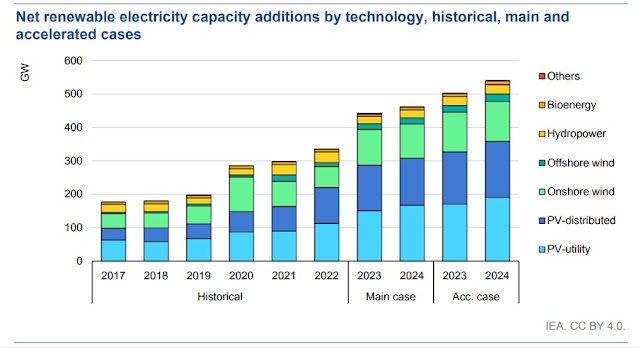"Solar and wind are leading the rapid expansion of the new global energy economy"
BRETT WILKINS for Common Dreams
Electricity generated by the sun and wind is set to soar to global record levels this year amid surging solar production and high fuel prices, a report published June 1 by the International Energy Agency forecasts.
The IEA's Renewable Energy Market Update
Outlook for 2023 and 2024 notes that "the global
energy crisis and policy momentum are driving robust growth in solar
photovoltaic (PV) and wind power."
Global additions of solar PV and wind are
set to increase 107 gigawatts to over 440GW this year, and growth will likely
continue next year to reach a total renewable energy capacity of 4.5
terawatts—the equivalent of the total combined electricity output of the United
States and China.
"Solar and wind are leading the rapid expansion of the new global energy economy. This year, the world is set to add a record-breaking amount of renewables to electricity systems—more than the total power capacity of Germany and Spain combined," IEA Executive Director Fatih Birol said in a statement.
"The global energy crisis has shown
renewables are critical for making energy supplies not just cleaner but also
more secure and affordable—and governments are responding with efforts to
deploy them faster," Birol added. "But achieving stronger growth
means addressing some key challenges. Policies need to adapt to changing market
conditions, and we need to upgrade and expand power grids to ensure we can take
full advantage of solar and wind's huge potential."
According to the report:
Solar PV capacity, including both large
utility-scale and small distributed systems, accounts for two-thirds of this
year's projected increase in global renewable capacity in response to higher
electricity prices caused by the global energy crisis, policymakers in many
countries, particularly in Europe, have actively sought alternatives to
imported fossil fuels that can improve energy security.
This shifting focus created a favorable environment for solar PV, especially
for residential and commercial systems that can be rapidly installed to meet
growing demand for renewable energy. These smaller distributed PV applications
are on track to account for half of this year's overall deployment of solar
PV—larger than the total deployment of onshore wind over the same period.
Meanwhile, the paper notes that
"following two consecutive years of decline, onshore wind capacity
additions are on course to rebound by 70% in 2023 to 107 GW, an all-time record
amount."
The report continues:
This is mainly due to the commissioning of
delayed projects in China following last year's Covid-19 restrictions. Faster
expansion is also expected in Europe and the United States as a result of
supply chain challenges pushing project commissioning from 2022 into 2023. On
the other hand, offshore wind growth is not expected to match the record
expansion it achieved two years ago due to the low volume of projects under
construction outside of China.
The report predicts that "solar PV
additions will continue to increase in 2024 while challenges remain for wind
expansion."
"Global renewable capacity additions
could reach 550 GW in 2024 in our accelerated case, almost 20% higher than in
the main forecast," the paper contends. "This is mainly due to a more
rapid deployment of residential and commercial PV installations, assuming a
faster implementation of recent policies and incentives."
Earlier this year, IEA predicted that renewable energy will
become the world's number one electricity source by 2025 thanks largely to a
surge in wind and solar.
"We are close to a tipping point for
power sector emissions," Birol said at the time. "Governments now
need to enable low-emissions sources to grow even faster and drive down
emissions so that the world can ensure secure electricity supplies while
reaching climate goals."
The latest IEA report comes as countries set their sights on a global target for renewable energy ahead of this winter's United Nations Climate Change Conference—also known as COP28—in the United Arab Emirates
